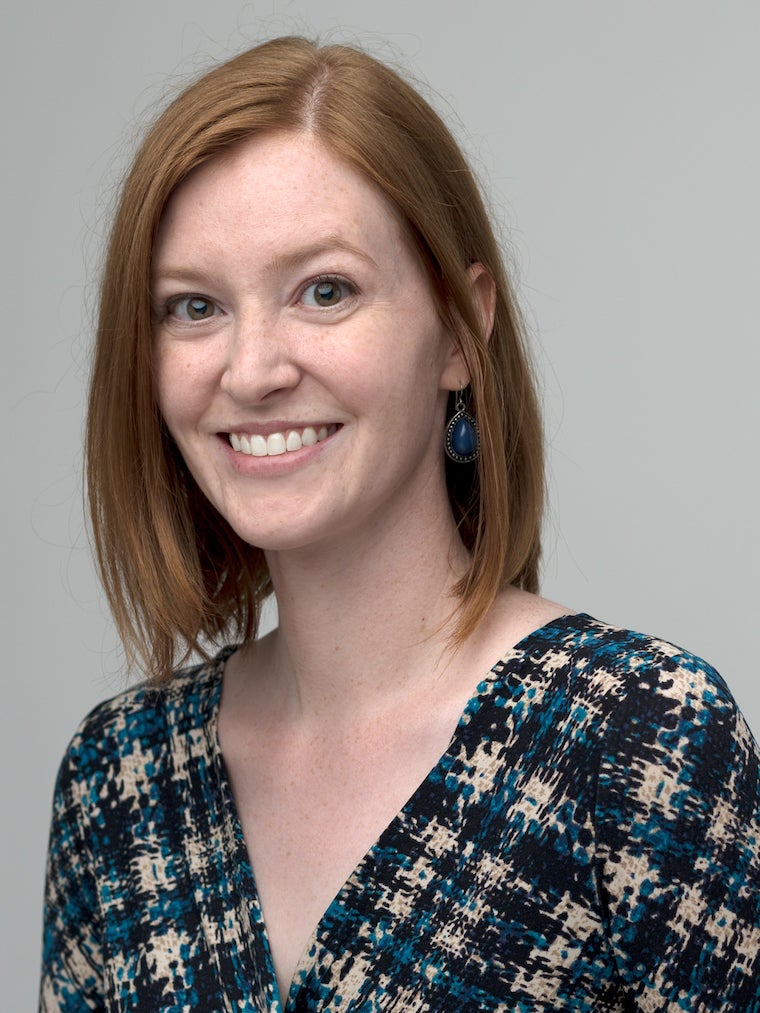Building an Inclusive Community in Chemistry and Beyond
March 6, 2018
Amanda Nagy

Photo credit: Nicolas Hen
Assistant Professor of Chemistry and Biochemistry Lisa Ryno is advancing her discovery of bacterial resistance to antibiotics with a grant from the Research Corporation for Scientific Advancement.
With the three-year, $100,000 grant, Ryno’s lab will investigate the relationship between signaling pathways and biofilm formation in E. coli. The overarching goal of Ryno’s research is to look for new cellular targets and pathways that can be exploited to make bacteria more sensitive to antibiotics, or could lead to the development of new antibiotics.
Ryno’s proposal encompasses a research plan, which involves training student collaborators, and an educational component to help improve retention of underrepresented students in science majors. For the educational plan, Ryno intends to create a near-peer mentoring system for groups of college and high school students to prepare them for entering a research laboratory.
“Students are the primary collectors of information,” Ryno says. “We train students to do all of the different experimental work that we use to make these discoveries. When this data is collected and synthesized into a paper, many student names will be on that paper because they will have contributed in a meaningful way. Our jobs as instructors extends well into the laboratory. I think that’s where my best teaching happens—when I’m with my students in my lab.”

Photo credit: Jennifer Manna
Ryno says academic science is particularly important for the innovation and discovery of new antibiotics because big pharmaceutical companies have stepped back from their investment in that area. She says there are several reasons for this, but mainly because an infection or a disease that’s caused by bacteria is episodic as opposed to a chronic disease, so it’s not as lucrative for a pharmaceutical company.
The prescribed antibiotics on the market have been in use for the last 50 years, and they work on the same five cellular pathways, Ryno explains. New antibiotics that come out are just modifications of the old ones; the same five pathways come into play.
“There’s big excitement in the field about finding new pathways or finding pathways that can be used in combination with already existing antibiotics,” she says. “For example, if you find a target and you have a drug that knocks that target out, that weakens the bacteria and makes it more sensitive to already approved antibiotics. That means you can use less of those drugs.”
In developing the educational portion of the proposal, Ryno says she was guided by the work Oberlin is doing with its Howard Hughes Medical Institute (HHMI) Inclusive Excellence Initiative.
“We’ve noticed there is a lack of retention of underrepresented students in the sciences once we get to the upper-division courses. There are a lot of theories as to why that’s happening and we’re working really hard to think about how we can make retention equal for all students.”
Those who fall into the underrepresented category include students of color, Pell-eligible, first-generation, and women. The mentoring system will seek out those students and build an inclusive community based on interdisciplinary experiences. Student mentor-mentee groups will participate in biweekly discussions about recently published scientific literature, have informal meetings and group activities, and participate in short courses preparing them for academic research.
Ryno also wants to create a time and space for students to learn about research during winter term.
“It’s not necessarily doing research, but how to do research,” she says. “This is an opportunity to learn about different techniques, how to read primary literature, and what it takes to put together a poster and oral presentation. Not all students are well equipped to walk into a professor’s office and ask to do research with them. That can be a big hurdle, especially for students who haven’t had a lot of guidance. This is a way to help bridge that.”
Ryno’s project seeks to tackle a topic that is a challenge for not just sciences, but other departments within Oberlin and beyond, says Rebecca Whelan, associate professor of chemistry and biochemistry and chair of the department.
“[Ryno] is in an ideal position to implement this project,” Whelan says. She is well versed in the literature regarding persistence and retention, and her proposal incorporates best practices tailored to our local environment. She presents a plan for assessment and addresses the ways that this plan may have broader impact.”
You may also like…
Friday Afternoon with Lab Crawl
This year’s Lab Crawl drew what may be the largest crowd in the event’s illustrious history, with some 500 students and dozens of faculty taking part. Missed out on the excitement? It looked something like this.
Lab Crawl: It’s Not Just for Scientists
Oct. 27 open house highlights research across the sciences—and just about everywhere else.
In the Path of Disaster
Monica Dix travels to a hub of natural calamity to probe its risks and resilience.


